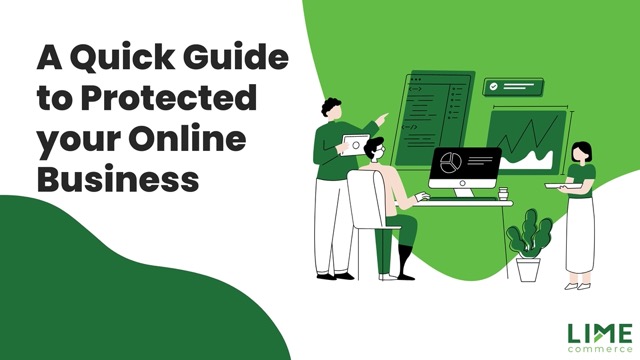
A Quick Guide to Protected your Online Business
10 November 2022
By Dipta
In this digital era, where business goes online, so do criminals. The risk of criminals is always there as long as money and opportunities exist. As an online business owner or entrepreneur, you should be well aware of this and strengthen your business with e-commerce security.
According to research by Webscale, some companies are losing more than U$5 million in stolen data, and many others have suffered losses of over US$100 million. These numbers do not include millions of consumers who lost their credit card and bank account details theft.
That’s why ensure that your e-commerce security is nothing less than a priority. And let’s dive deep into e-commerce security in this article.
What is E-Commerce Security?
Ecommerce security protects e-commerce assets from unauthorized access, use, alteration, or destruction. It also refers to a globally recognized set of guidelines that ensure a safe and secure online shopping experience. It includes protocols that protect both businesses that sell products online and the customers with whom they share personal information to purchase those products.
There are four aspects of basic e-commerce security that you need to understand when setting up the kind of protocol for your own web store. These include:
- Authentication establishes that both the buyer and the seller are who they are and the verifiable identities of who they are.
- Privacy, which specifically refers to the protection of Customer Data from unauthorized third parties.
- Integrity means that this data has not been edited or altered in any way.
- Non-repudiation. It is the legal principle that enforces the execution of trades.
Why is Security Important in E-Commerce?
According to Security Metrics data in 2021, 88.89 percent of Shopping Cart Inspect reviews identified malicious, suspicious, and or concerning issues on researched e-commerce sites. 25.3 percent of inspected e-commerce sites had malicious issues, 63.86 percent of inspected e-commerce sites had suspicious issues, and 33.73 percent of inspected e-commerce sites had concerning issues.
Knowing this fact, e-commerce security is an essential thing. And here are the importance of e-commerce security.
1. Minimize the Risk
Every e-commerce business is vulnerable to online security breaches and cyberattacks. These security risks include phishing, website hacking, and unprotected web services. Besides, suspicious transactions and stolen credit card information are common risks in e-commerce businesses.
Hackers or others can use stolen credit cards to make online transactions. And they also can infiltrate a company’s network and gain access to sensitive information. Therefore, solid and powerful e-commerce website security must intercept suspicious transactions and online security breaches.
2. Build Customer Trust
Customer trust is one of the top priorities for any business, and it’s more challenging than many people think. To build trust, companies must be transparent and open about their data collection methods and procedures. And by building trust, companies can increase loyal customers and reduce the churn rate. You must take the necessary steps and send the logs. Additionally, you can give your customers more peace of mind by creating a public document outlining the precautions you are taking to protect them.
You can turn your customers into service or product advocates by prioritizing privacy. Through various surveys and feedback forms, customers may be solicited for their opinion of the current privacy policy.
3. Ransomware Protection
Another digital security threat to e-commerce businesses is ransomware, a type of malware that encrypts corporate data. Unlocking data or systems requires a significant amount of money. Data stored on your system can be at risk and attacked by ransomware.
Not only can devices be affected, but there have also been some instances of ransomware attacks against cloud storage. However, cloud storage is still considered a more secure option, and more businesses are opting for it.
The only way to protect against this attack is to be prepared. And how do you do that? You can be prepared by backing up your important files to several locations. It is not limited to cloud services but also local and portable storage devices.
4. Streamlined Business Processes
Organizations upgrade their software to add functionality and enable their systems to perform the tasks they need. Most updates contain significant security improvements. It speeds up the process by eliminating errors.
Updates can grow in volume over time, so it’s important to keep an eye on them. You also need to update your e-commerce website and applications to eliminate bugs and provide a better experience for your customers. Building security into your e-commerce optimization keeps everything running smoothly.
The Type of E-commerce Security Attacks
Cyberattack statistics are alarming. In 2021, 50% of all cyberattacks were carried out against small and medium businesses. But why is that? It is because e-commerce websites are rich data sources, sensitive information, and capital. Exploiting e-commerce security flaws is a lucrative business for malicious actors or hackers.
These vulnerabilities can take many forms, including threats from insiders, customers, and even natural disasters. Protecting against these e-commerce security threats requires various tools that must be updated and consistently maintained to protect your business and your customers.
And below are the main threats to e-commerce security that every business should know and anticipate.
1. Pishing
One of the most common types of cyber attacks is phishing. Phishing is sending fraudulent communications that appear to come from a reputable source and is usually performed through email, phone calls, or texts. The purpose of phishing is to steal personal and confidential information like accounts, passwords, social security numbers, and much more.
For e-commerce businesses, this phishing attack can cause devastating damage to both businesses and customers. If it is not identified and appropriately resolved, phishing can ruin the reputation of brands or businesses.
2. Malware and Ransomware
Malicious software, commonly known as malware, is installed on systems by attackers. Ransomware is malware that locks victims out of their systems and prevents them from accessing their data unless some “ransom” is paid. Ransomware attacks have targeted banks, schools, and even hospitals, causing US$21 billion in losses globally in 2021. Here are some common signs of a malware attack:
- Hard-to-Click Ads
- Slow System Crashing/Freezing Repeatedly
- Too Many Emails Sent Bounced
- New Icon Appearing on the Desktop Without Being Installed
3. Cross-Site Scripting XXS
XSS or Cross-Site Scripting is an e-commerce security threat in which hackers add malicious code to legitimate websites. The code then attacks users who browse her infected website. XSS can lead to identity theft, keystroke logging, file/webcam/microphone access, and identity theft.
4. E-Skimming
E-Skimming is also known as credit card skimming. In the physical world, skimmers are installed through credit card readers to skim credit card information. In contrast, e-skimmers are malicious code that steals customer credit card details during online transactions.
5. Man-in-the-middle attack
MTM attack is a so-called “active eavesdropping attack.” A third party intercepts conversations or data transmissions between the two parties. This third party can also inject malware into exchanged files, infecting other systems once the attack is complete.
6. SQL Injection Attacks
Most e-commerce websites maintain databases of customer information such as email addresses, addresses, and phone numbers. SQL injection attacks can allow unauthorized users to access these databases. A hacker can use malicious code to bypass the authentication page and gain access to the full backend database. From there, users can steal, modify, or delete data.
7. Financial Fraud
Financial Fraud is a different type of e-commerce security threat, such as SQL injection. Instead of relying on malicious code, financial fraudsters use stolen credit cards to make a profit at the company’s expense. If credit card fraud is detected, the e-commerce site must refund the victim without taking back the items sold.
E-commerce Security Measures to Protect Your Website
Security threats in e-commerce are constant threats. You must proactively defend against these threats and allow your customers to browse your e-commerce website safely without fear of fraud or theft. And here are the prudent steps to reduce the risk of e-commerce security threats.
-
Setting up a Virtual Private Network (VPN)
A Virtual Private Network (VPN) provides a secure way to send data over potentially insecure public networks such as the Internet.
The Internet isn’t always as secure as you might think. Taking extra precautions against online hackers is especially important when your mission is to provide your users and customers with a great online shopping experience. Why? It requires a lot of information, so it’s information security that can’t be compromised.
Setting up a VPN (Virtual Private Network) connection helps keep your connection secure and your data private. You may be familiar with VPNs to protect your privacy when using the Internet. However, you can also use a VPN to protect your company’s network. In fact, VPNs were originally designed to allow remote workers to connect to company networks without compromising security.
If you use an Enterprise Resource Planning (ERP) system with an online portal, you can similarly use a VPN to protect your integrated ERP. All data sent over the virtual private network is encrypted.
-
Switch to HTTPS
HTTP is the standard data transfer method on the Internet. HTTPS provides an encryption layer for this data. Using HTTPS prevents most man-in-the-middle attacks. All e-commerce websites must use at least HTTPS. Many browsers block users from opening their web pages other than HTTPS.
-
Deploying a secure payment processing platform
A secure payment processing platform is like an armored car for online payments. Protect your financial data in every transaction and prevent credit card spying and transaction interception.
-
Use multi-factor authentication to enhance privacy
Multi-factor authentication (MFA) can be an important tool for e-commerce security, especially when protecting customer purchases and preventing data loss. And always make consistent backups because site compromise can lead to data loss. Creating regular backups can minimize the lead time for a full recovery.
-
Choose a trusted platform for your data
Please review your e-commerce provider properly to ensure it provides the necessary security measures. Multiple layers of security make unauthorized access difficult. The result is a process that minimizes the amount of time spent reviewing security measures without worrying that security measures need to be done correctly.
-
Make sure to create strong passwords
A quick, often overlooked tip: Making sure both you and your customers use strong passwords goes a long way in securing your online portal. A strong password consists of at least eight characters with a combination of uppercase, and lowercase letters, numbers, and special characters.
-
Install Device Protection
Add a second layer of security to your data and e-commerce by installing reputable antivirus software, firewalling your network, and ensuring regular updates for these platforms. You can prevent platform disruptions.
The Takeaways
E-commerce security is something that must not be compromised, especially in this seriously damaged cyberattack era. And it should be a process that requires continuous monitoring with an eagle eye because cyber security attacks and threats constantly evolve.
If you take steps to prevent this thoughtfully and meticulously, your customers will feel secure when making purchases and transactions on your online store. That’s why every e-commerce business should start working on digital backups.
If you want to build a safe and secure e-commerce website, Lime Commerce is here to help you with over eight years of experience delivering excellence for our clients. Talk to us about your business needs and how we can help.
